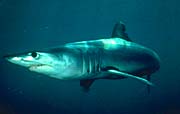
Overview
Introduction
to Sharks
Tagging and Migration
What Does Tagging Have To Do With Migration?
How Are Sharks Tagged?
Latitude and Longitude: Recording and Reporting Locations
Workbook
Activities
for Classroom
Shark Tagging Learning Activity
Shortfin Mako Shark
 The Shortfin mako is the quintessential shark. It is probably the most graceful of all
sharks, the most beautifully proportioned, the fastest, the most strikingly
colored, the most-spectacular game fish, and one of the meanest-looking animals
on earth.” (Richard Ellis, The Book of Sharks) The Shortfin mako is one of the so-called
“supersharks” – steely blue in color with a long pointed snout and curved,
dagger-like teeth, it is beautiful, powerful, aggressive, and tremendously
strong. It is believed to be the fastest of all the sharks and definitely holds
the record for both long distance travel and for spectacular leaps out of the
water. The shortfin mako has even been known to attack boats, particularly if it
has been hooked by a fisherman.
The Shortfin mako is the quintessential shark. It is probably the most graceful of all
sharks, the most beautifully proportioned, the fastest, the most strikingly
colored, the most-spectacular game fish, and one of the meanest-looking animals
on earth.” (Richard Ellis, The Book of Sharks) The Shortfin mako is one of the so-called
“supersharks” – steely blue in color with a long pointed snout and curved,
dagger-like teeth, it is beautiful, powerful, aggressive, and tremendously
strong. It is believed to be the fastest of all the sharks and definitely holds
the record for both long distance travel and for spectacular leaps out of the
water. The shortfin mako has even been known to attack boats, particularly if it
has been hooked by a fisherman.
Like its close relative, the great white, the mako is a streamlined, fast and powerful swimmer. Also like the great white, it is able to conserve body heat and maintain a higher body temperature than the surrounding water. In order to maintain this higher metabolism, they must consume a large quantity of fatty foods – fast moving tunas, swordfish, herring, bluefish, squid, and other sharks.
The shortfin mako is distributed world-wide throughout the tropical and temperate zones of the world’s oceans, and is commonly found well off-shore in deeper waters. It migrates seasonally and has been studied heavily in the north Atlantic. In the northwestern Atlantic, the shortfin mako ranges all the way from the Grand Banks in high summer to the tropics in winter. It is most common from Cape Cod to Cape Hatteras, North Carolina.
Shortfin mako sharks have a fairly narrow preferred temperature range of approximately 17°-22°C (62.6-71.7°F). In the North Atlantic part of their range, shortfin makos migrate from the Sargasso Sea towards the mid-Atlantic and northeastern coast of the U.S. in early summer as coastal waters begin to warm. When north Atlantic waters begin to warm to 16°C-17°C (60.8-62.6°F), shortfin makos can be found along the continental shelf from Cape Hatteras, North Carolina to Georges Bank, off the coast of Massachusetts. In November and December, when water temperatures begin to go below 17°C, these sharks begin to return to warmer waters in the Sargasso Sea. The migration patterns of shortfin makos is also associated with the migrations of their food fish. Shortfin makos usually feed on schooling fish such as bluefish, and on larger fish that also follow the schooling fish, such as swordfish, tuna, and marlin. As the schooling fish migrate, the larger fish that prey on them follow.
Copyright © Ocean Of Know